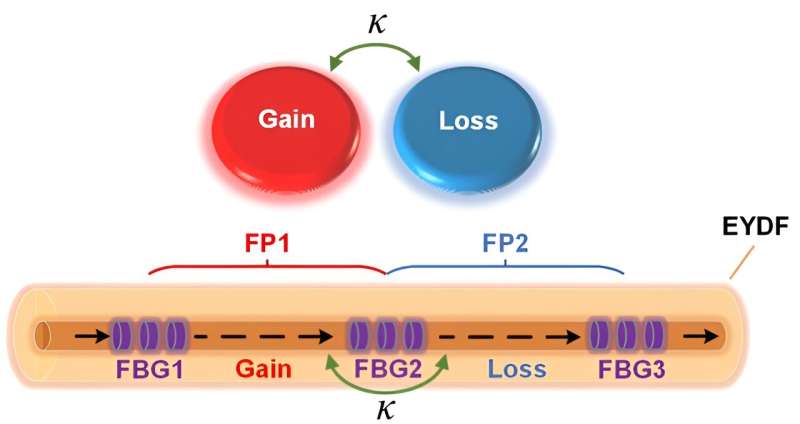This article has been reviewed according to Science X's editorial process and policies. Editors have highlighted the following attributes while ensuring the content's credibility:
fact-checked
proofread
Exceptional-point-enhanced sensitivity: A new paradigm for high-sensitivity fiber sensors

The sensitivity of a fiber sensor can be enhanced severalfold using an exceptional point (EP), according to a recent paper published in Opto-Electronic Advances. The technique has the potential to transform fiber sensing technology toward a new era of precision and accuracy. While the researchers demonstrated this remarkable capability using a bending sensor, the true power of EP-enhanced sensitivity extends far beyond, with potential applications across various existing fiber sensors.
The foundation of this innovation is a carefully designed fiber-optic bending sensor, leveraging the EP concept to achieve extraordinary sensitivity. The sensor consists of two specialized Fabry-Perot (FP) resonators, each embedded with two fiber Bragg gratings (FBGs) inscribed in an erbium-ytterbium co-doped fiber (EYDF). By controlling the pumping power, the gain and loss of these resonators are precisely tuned to activate the sensitivity enhancement by operating the sensor near its exceptional point.
Once a bending force is applied to the sensor, its operation moves away from the exceptional point, leading to a distinctive frequency-splitting phenomenon. This unique frequency response enables the sensor to detect the slightest bend or curve with high sensitivity and precision.
To realize the full potential of this EP-enhanced sensitivity, the researchers devised a dual-passband microwave-photonic filter, converting the optical spectral response of sensor to the microwave domain. This clever integration allows for high-speed and high-resolution measurements, unleashing the full power of EP-enhanced sensing.
Through rigorous experimental evaluations, the EP-enhanced sensor showcased remarkable results. With a curvature sensing range from 0.28 to 2.74 m-1, it achieved an accuracy of 7.56 × 10-4 m-1 and an exceptionally high sensitivity of 1.32 GHz/m-1. These extraordinary outcomes surpassed previous fiber sensor capabilities, demonstrating the notable potential of EP-enhanced sensitivity.
The discovery of EP-enhanced sensitivity represents a paradigm shift in fiber sensing. Beyond the bending sensor application, this powerful technique can be easily deployed in many existing fiber sensors for elevated precision.
The authors of this article introduce an exceptional-point-enhanced bending sensor within an all-fiber optic structure. The study has achieved noteworthy results through careful design and experimental validation of the sensor.
The key innovation lies in utilizing the unique properties of EPs in optical fibers to achieve highly sensitive detection of bending forces near a specific point. When an external bending force is applied, the optical modes at the EP undergo splitting, resulting in a frequency splitting phenomenon. This phenomenon provides valuable information about the external bending force, enabling precise measurements.
In contrast to conventional linear sensors, the EP-enhanced sensor exhibits a nonlinear response near the EP, leading to significantly increased sensitivity. Additionally, to achieve high-speed and high-resolution sensor measurements, microwave photonics technique is employed, to translate the optical spectral response of the sensor to the microwave domain, enabling high-resolution measurements with enhanced overall performance.
This fiber optic sensing technology offers a cost-effective solution to improve the sensitivity of traditional Hermitian fiber optic sensors. The versatility of the technique allows for its application to various existing FBG sensors, making it easier to implement in scenarios where high sensitivity is required.
The ability of the EP-point-enhanced bending sensor to detect weak signals makes it extremely useful for safeguarding critical infrastructures, especially at the initial stages of safety accidents, such as tunnels, bridges, and nuclear power plants. Early warnings enabled by this sensor can mitigate economic and human losses, providing significant societal benefits.
In conclusion, this research represents a notable contribution to fiber optic sensing. The unique capabilities of the EP-enhanced bending sensor enhance precision and sensitivity in a cost-effective manner, making it a promising advancement in the field. The potential to apply this technology to existing fiber optic sensors and its application in safeguarding critical infrastructures signify the far-reaching impact it can have on safety and innovation in various industries. This work sets the stage for further advancements in fiber optic sensing, opening new possibilities for high-sensitivity measurements with implications for broader practical applications.
More information: Zheng Li et al, Exceptional-point-enhanced sensing in an all-fiber bending sensor, Opto-Electronic Advances (2023). DOI: 10.29026/oea.2023.230019
Provided by Compuscript Ltd




















